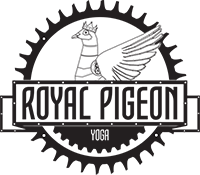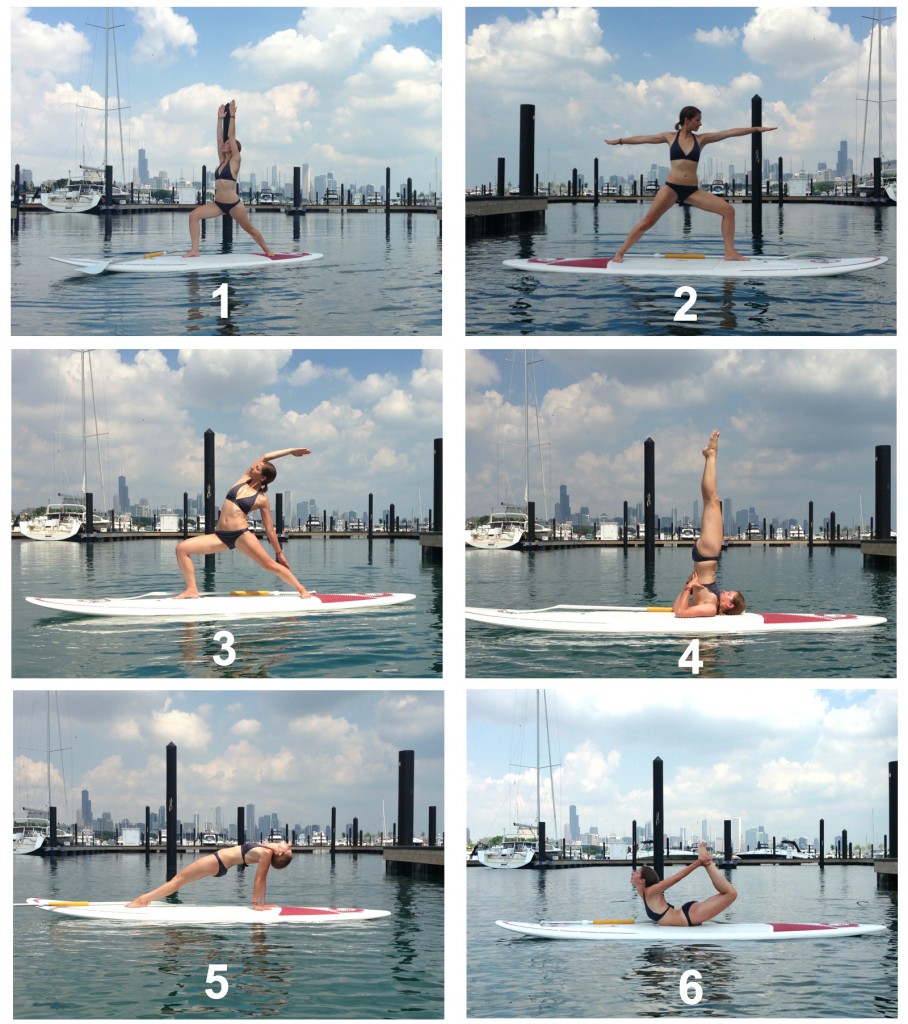1.) Virabhadrasana I (Warrior 1)
There are a couple of ways to get into Warrior 1 on the paddle board but I have found that students find it easiest to come into out of downward facing dog.
From down-dog inhale and lift the right leg. Engage the core and flex the right foot engage the muscles in the right leg. Take a breath here. Bend the knee in towards the chest and bring the shoulders over the wrists. Drop the foot in between the hands or just above the handle in the middle of the board. You may need to use your hands to help move your foot or you may heel-toe the foot into place. The front toes will point forward. Keep the front foot parallel to the sides of the board. Spiral the back foot; the heel should point to the left side of the board creating a perpendicular line between the left, back foot and the right, front foot. Keep the front leg bent (knees directly over ankles). Push down into the front and back foot as you reach forward to come up. Square hips towards the front of the board.
Balance Tips: Think of an anchor dropping from the base of the pelvic floor to the bottom of the body of water you’re on. The knees come forward over the ankle towards the middle right toe. You can also think of tearing the board apart with the bottom of your feet; the energy drives forward in the front foot and back in the left foot.
Take 3-5 complete breaths here (inhale/exhale 1…).
2.) Virabhadrasana II (Warrior 2)
From Warrior 1. Keep the right knee bent over the ankle. Open the left hip (left hip comes back, right hip comes forward) and allow the left arm to spiral up and over the head until your arms are in one straight line; the left finger tips point to the back of the board, palms facing down. The right hand is directly in front of you, fingers forward, palm facing the top of the paddle board. Try to get the the right leg as parallel to board as possible by sinking further into the pose. Keep the weight distributed evenly between the front and the back feet.
Don’t give up!: Focus: gaze out over the right middle finger; this is your DRISHTI and in the simplest terms means seeing. It is also commonly known as a point of focus or gazing technique. Concentrate on that point as you draw breath into your body and exhale. Release and surrender into the pose. Proper alignment and an engaged core will keep you balanced.
Take 3-5 complete breaths here (inhale/exhale 1…). Before coming into the next pose, reverse warrior, you may straighten and re-bend the front knee.
3.) Viparita Virabhadrasana (Reverse Warrior)
From Warrior 2. Flip the front palm up; reach forward with the right arm. Raise the right arm up and over your head. Drop the left hand to the left leg. Notice the slight back bend as your hand rises up; let the head fall back and walk the left hand down the left leg. Send the right knee forward. Distribute the weight evenly in the front and back leg; pretend again as if you are tearing the board apart with your feet. Take 3-5 breaths here (inhale/exhale 1…). Reach the right hand forward and square the hips. Bring the left hand forward. Hinge at the hips with torso moving towards the board. Release the hands onto the board. Extend the right leg back. Complete a vinyasa flow or push back into down-dog. Raise the left leg and continue on the left side.
4.) Salamba Sarvangasana (Supported Shoulder Stand)
From down-dog. Bring shoulders over wrists: plank pose. Bend elbows and lower down onto the board. Flip over onto your back. Take a moment here and feel underneath your body to make sure your hip line is at the top of the handle hole in the center of the board. If there is no handle or space in the center of the board, position your body so that your feet are roughly 18-24 inches away from the nose or tip of the board. Bend knees in towards the chest. Place hands on gluteus maximus, palms pushing into them gently. Find your balance. Lift your hips and draw your knees towards the sky. Move your hands slowly to the middle of your back. Use them as support. Straighten the legs and try to align the hips directly over the shoulders.
“I’m scared!”: Don’t be! Engage your legs and press the feet against the sky. Keep ankles over knees and knees over hips. Use your hands to support your low back. Engage your core to draw your hips over your shoulder and/or prevent your hips from falling past your head. Push past self-imposed limitations, BUT, be safe doing so. Go as far as you can and do not strain your body to the point of pain. It is with practice that you will progress.
Concentrate pushing towards the sky as if someone was pulling you up by the legs. Rest the chin in the crevice of your clavicle. Take 3-5 complete breaths here (inhale/exhale 1…). SLOWLY and with control, bend the knees and draw them towards your forehead. Lower the upper, middle, and lower back. Extend the legs in front of you and place arms at your sides. **Please note: in the picture I am shown facing the front of the board- you may face either the back or the front. You will have more balance if you face the front- though you will have to transition accordingly.
5.) Purvottasana (Inclined Plane Pose)
From reclined position after shoulder stand. Push into your hands and sit up; legs extend towards the front of the board. Flex the feet to engage the leg muscles. Place hands roughly 6-7 inches (about a hand’s length) behind you. Keep them shoulder distance apart with finger tips pointing to the back of the board. Inhale; roll shoulders up and back. Exhale; lift hips. Point toes forward and press feet into the board. Slowly release head by looking up and then looking behind you. Keep raising the hips and pressing the feet firmly into the board. Take 3-5 complete breaths here (inhale/exhale 1…). Gently bring the head back to forward. Lower the hips to the board. Flex the feet. Bring the chest forward. Release the hands.
**Please note: in the picture I am shown facing the front of the board- you may face either the back or the front. You will have more balance if you face the front- though you will have to transition accordingly.
6.) Dhanurasana (Bow pose)
From sitting up. Use your hands to help you lie down onto your stomach. Position your body so the navel is directly on top or below the handle in the center of the board. Rest chin on the board. Place your hands at your side, palms up. Bend the knees and drop heels towards the body. Reach both hands behind you and grab the ankles. Flex the feet and kick the ankles lightly into the palms of your hands to square off the shoulders. Inhale and exhale deeply. Inhale; fully kick into your hands to raise your chest and thighs off of the board. Draw the toes together. Look up.
Be a bow: In order to create a curve in the body reach the chest forward by drawing your shoulder blades together, kick higher, and try to place the weight of your body onto the navel. Your weight should not be resting on your hips. Take 3-5 complete breaths here (inhale/exhale 1…). Slowly lower the knees and the chest. Release the ankles and allow the feet to rest on top of the board. Release the hands at your sides and place the left or right cheek down. Press the pelvis into the board and shake your hips from side to side for a few moments. Keep the breath moving. Switch cheeks and repeat.
Once you are familiar with these poses begin to increase the length of time you stay in each pose until you reach 20 to 30 seconds; this is roughly 7 to 10 complete breaths (inhale/exhale 1…).
“Knowledge is of no value unless you put it into practice.” Anton Chekhov




